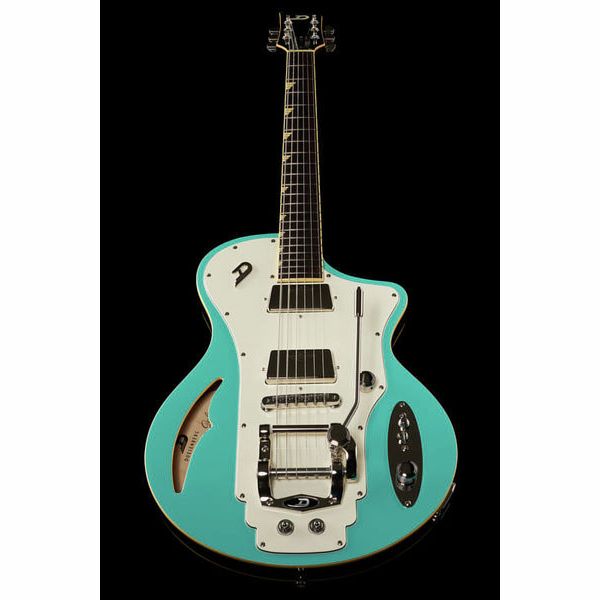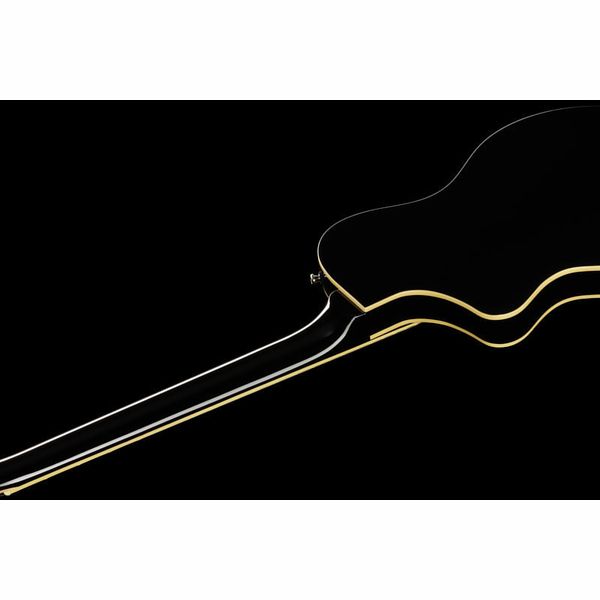Duesenberg Julia Narvik-Blue
Le caratteristiche della chitarra Duesenberg Julia Narvik-Blue :
Chambered body: Mahogany
Top: Maple with F-hole
Set-in neck: Maple
Fretboard: Rosewood (Dalbergia latifolia)
Body dimensions: 45 x 33 x 3.9 cm
Wings fretboard inlays
Fretboard radius: 305 mm (12″)
Scale: 648 mm (25.5″)
Nut width: 42 mm
22 Jumbo frets
Dual action truss rod
Pickups: Duesenberg Domino P90 and Split/King Dual-Coil
1 Master volume and 1 master tone control
3-Way switch
Split switch
DirectOut switch
Crystaloid pickguard
Bridge: Steel Saddle Radius
Duesenberg Deluxe Tremola tremolo
Duesenberg Z-machine heads with Art Diego buttons
Nickel hardware
Original strings: Duesenberg DSA10 .010, .013, .017, .028, .042, .050
Colour: Narvik Blue
Incl. Duesenberg case
In catalogo dal Maggio 2018
Numero di articolo 432845
Unitá incluse 1 Pezzo
Colour Blue
Soundboard Mahogany
Neck Maple
Fretboard Rosewood
Frets 22
Scale 648 mm
Pickup System H, P90
Tremolo Yes
Incl. Case Yes
Incl. Gigbag No
Design Solid Body
Top Maple
Quante corde? (Duesenberg Julia Narvik-Blue)
Le corde della chitarra elettrica sono fatte di acciaio o di nickel.
I chitarristi suonano con un plettro per evitare dolori alle mani.
Chitarra elettrica a sette corde
Una chitarra a 7 corde è un modello di chitarra per il chitarrista metal. Inoltre, ci sono anche delle chitarre elettriche jazz con sette corde.
Le corde di queste chitarre sono simili a quelle delle chitarre elettriche a 6 corde. Ma hanno una corda aggiuntiva che ha una nota più grave.
La chitarra a 6 corde
Una chitarra a sei corde ha tre corde gravi e tre corde acute.
La chitarra a dodici corde
La chitarra a dodici corde era molto utilizzata da alcune orchestre folk negli anni ’60. La chitarra ha la stessa accordatura di una chitarra elettrica a 6 corde, ma.
Tecniche di fissaggio al corpo della chitarra elettrica (Duesenberg Julia Narvik-Blue)
The method by which the neck is attached to the body of the electric guitar plays an important role in the sound of the instrument. In fact, there are three major methods of joining the neck to the body:
- the bolt-on neck
- the through-neck
- the set neck
The set neck
The joint is made with a mortise and tenon joint.
Made famous by Gibson, then PRS, it enhances sustain and vibrato.
The bolt-on neck
Initially used by Fender, this technique produces instruments that can be taken apart, with various parts being replaceable.
This attachment method provides brightness to the electric guitar.
The through-neck or neck-thru
This approach is the most expensive.
However, the quality-price ratio is often worth it.
The neck runs from one end of the guitar to the other and is fully integrated into the body. As a result, it ensures perfect transmission of vibrations.
The type of pickup for an electric guitar (Duesenberg Julia Narvik-Blue)
In order to choose an electric guitar, it is also recommended to pay attention to the pickups. The pickups differ in terms of their winding.
You can then distinguish between:
- Guitars with single coil and humbucker pickups.
- Guitars with a humbucker pickup, such as Gibson, have a higher output volume.
- Guitars with a single coil pickup are more suitable for country, blues and rock music.
The bodies (Duesenberg Julia Narvik-Blue)
The type of resonance chamber has an effect on the sound of the guitar.
Solid body
Easily handled thanks to its lightweight body.
Semi-hollow body
It combines the advantages of both other bodies (hollow and solid).
Hollow body
The hollow body is mainly used for jazz music.
This type of body produces wonderful sounds for acoustic and electro-acoustic guitars.
It is perfect for novice guitarists.
The sound resonates more. It is much clearer.
The main woods of electric guitars (Duesenberg Julia Narvik-Blue)
The woods used by many professional luthiers will determine the sound and resonance of the guitar.
As for the neck, the most common woods on the market are maple and mahogany.
As for the fingerboard, you can usually find:
- rosewood
- maple
- ebony
Changing the type of wood can change the sound. Here are the two most common wood species:
Rosewood
A dark wood, with admirable hardness and density, it is used to make the fingerboard of the guitar.
Mahogany
It provides a deep sound, rather round with good sustain.
The right technique for buying an electric guitar? (Duesenberg Julia Narvik-Blue)
Due to its small size, an electric guitar is suitable for all guitarists, even beginners. To choose the right one for you, there are several selection criteria that should be considered by the guitarist.
This includes:
- The pickups
- The bodies
- The attachment techniques to the body
- The number of strings
- The wood
- The neck
The characteristics of the guitar neck (Duesenberg Julia Narvik-Blue)
The length of a neck varies depending on the musical instrument. Although the difference may not be significant, it affects the string playability.
A short electric guitar scale length
Since the strings are less tense and more flexible, playing becomes easier, as is the case with Les Paul guitars.
A longer scale length
When the guitar neck is longer, like that of a Stratocaster or an Ibanez, their vibration is livelier and the tension exerted on the strings increases.
Guitar scale length
The scale length represents the vibrating dimension of the strings between the bridge and nut. This dimension affects not only the sound but also playing comfort.
In fact, a smaller scale length will feel more flexible.











